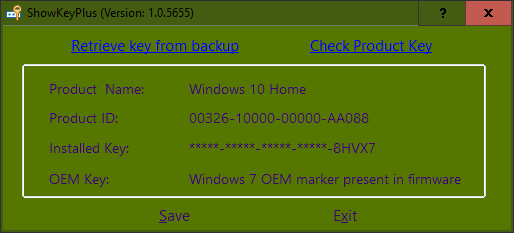- Get Windows 10 Serial Key From Os Download
- Get My Windows 10 Key
- Get Windows 10 Serial Key From Oscar
- Get Key From Windows 10
Getting Windows serial number (was: Getting MachineGuid from Registry). You can actually get the Windows serial number. It took me some searching and experimenting. Windows 10 Activation Keys is the most recent update of Windows by Microsoft. Microsoft is the world’s most leading operating system development company. It has delivered the variety of standard operating system in the past and providing the better OS to worldwide.
How can I get windows product key in C# ?
I want to get some key like windows key from client side.
Damien_The_Unbeliever6 Answers
Windows Product Key Finder and other solutions mentioned here by Erij J. and others are working for Windows XP and Windows 7 only. Microsoft has changed key encryption algorithm since Windows 8.
I've found a solution for Windows 8 and up on blogpost here:http://winaero.com/blog/how-to-view-your-product-key-in-windows-10-windows-8-and-windows-7/
However it is written in VBS, so I've rewritten it to C#.

You can check full project on GitHub: https://github.com/mrpeardotnet/WinProdKeyFinder
Get Windows 10 Serial Key From Os Download
Here is the code how to decode product key in Windows 8 and up:
To check Windows version and get digitalProductId use wrapper method like this:
I've tested it on several machines and it was giving me correct results. Even on Windows 10 I was able to get generic Windows 10 code (on upgraded system).
Note: For me the original vbs script was returning wrong Win7 keys despite the fact that original blogpost states the code works for Win7 and up. So I always fallback to the well known old method for Win7 and lower.
Hope it helps.
Get My Windows 10 Key
WMI has a class, called Win32_OperatingSystem that contains a property called SerialNumber:
Operating system product serial identification number.
Example: '10497-OEM-0031416-71674'
Get Windows 10 Serial Key From Oscar
The System.Management namespace contains classes that allow .NET code to interact with WMI.
Check out Windows Product Key Finder.
Source is available.
The key is stored in the registry and needs to be decoded using an algorithm available in the source.
Eric J.Get Key From Windows 10
Eric J.loot at http://www.codeproject.com/Articles/23334/Microsoft-Product-Key-Finder
Going with mrpeardotnet's answer...
I was getting errors where RegistryView.Default would not convert to string.I changed this:
to this:
and it seems to work.
Quill
Using this code, you can find the product key of your Microsoft products.
Referenced by : http://www.codeproject.com/Articles/23334/Microsoft-Product-Key-Finder
Gaurav AgrawalGaurav Agrawalprotected by Community♦Jan 22 at 11:44
Thank you for your interest in this question. Because it has attracted low-quality or spam answers that had to be removed, posting an answer now requires 10 reputation on this site (the association bonus does not count).
Would you like to answer one of these unanswered questions instead?
Not the answer you're looking for? Browse other questions tagged c#c#-4.0 or ask your own question.
Do you remember the good old times when PC manufacturers used to apply those fancy stickers to the back of your laptop or desktop PC depicting your Windows Product Key? If you’re a system administrator you probably already know that these times are gone since Windows 8. Now almost every PC with a pre-installed copy of a Windows OS doesn’t show any physical info or evidence of its product key, nor it features a Certificate of Authenticity (COA) sticker on its back, battery bay or any other place.
The product key is now embedded into the computer BIOS or UEFI, and it can only be accessed there: this also means that we don’t need to type it anymore, because it’s automatically fetched by the OS during the install phase. This can be really good at times, because you won’t ever need to remember or protect it – the system will do the hard work for you. However, it can become a huge problem if you ever need to type it, which is something that can always happen in some edge-case scenarious such as: relevant hardware upgrades, damaged/erased BIOS, OS upgrades, reinstall using a different ISO image and so on.
Whenever such things happens, we most certainly want (or would’ve wanted) a way to retrieve that product key before it’s too late. Luckily enough, there’s a great freeware tool that comes to the rescue: it’s called Windows 10 Product Key Tool and is made by NeoSmart technologies, the same guys that developed the great EasyBCD software (if you don’t know it, check it out!). The tool is compatible with both 32-bit and 64-bit versions of Windows 7, Windows 8.1, and Windows 10.
This handy tool can be downloaded here from the NeoSmart official blog. Once executed, it will retrieve our Windows Product Key from the BIOS / UEFI and show it to us in a convenient pop-up window:
In case the Windows installation has been performed by manually typing a OEM Product Key or using the free Windows 10 upgrade offer from Windows 7, Windows 8 or Windows 8.1, this tool won’t find anything in the BIOS / UEFI records, thus showing a “Unable to open MSDM table” error message instead:
If that’s the case, it simply means that our Product Key is stored into the Windows Registry. Don’t worry! This only means that, in order to recover it, we will need to use the good old ProduKey tool by Nirsoft, which helps users and SysAdmins to recover Windows, Office and SQL Server Serial Numbers, License Keys and Product Keys since 2005. Despite the rather rusty interface it still flawlessly gets the job done, just like it used to do since the early days of Windows XP:
That’s it for now: happy recover!
Comments are closed.